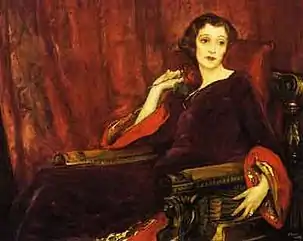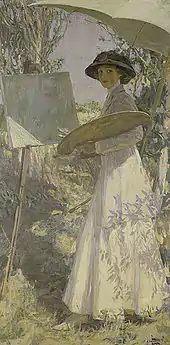Hazel Lavery
Hazel, Lady Lavery (née Martyn; 1880–1935) was a painter and the second wife of portrait artist Sir John Lavery. Her likeness appeared on Banknotes of Ireland for much of the 20th century.[1]
Hazel Lady Lavery | |
|---|---|
 | |
| Born | Hazel Martyn March 14, 1880 |
| Died | January 1, 1935 (aged 54) London, England |
| Nationality | American |
| Spouse(s) | Edward Livingston Trudeau Jr.
(m. 1903; died 1904) |
Early life

Born in Chicago on 14 March 1880,[2] Hazel Martyn was the daughter of Edward Jenner Martyn, a wealthy industrialist of Irish descent. A contemporary account refers to young Hazel Martyn as "The Most Beautiful Girl in the Midwest".[1][3] Hazel had one sister, Dorothea Hope "Dorothy" Martyn (1887–1911), who was an aspiring playwright. Suffering from anorexia nervosa, Dorothy died in 1911 aged 23, and it is her death that spurred Hazel to leave America.[2]
Personal life
In 1903, she married Edward Livingston Trudeau Jr, son of Edward Livingston Trudeau, a doctor who advanced the treatment of tuberculosis. Trudeau, himself a physician, died five months later.[4] They had one daughter, Alice, born 10 October 1904.[2]
While still married to Trudeau, she met John Lavery, a Catholic-born painter originally from Belfast.[1] Her husband died shortly thereafter, and in 1909 she and Lavery married. Subsequently, she became Lavery's most frequent sitter.[5]
During World War I, John Lavery became an official artist for the British government. In 1918, he received a knighthood, and Hazel Lavery became Lady Lavery.[6]
The Laverys lent their palatial house at 5 Cromwell Place in South Kensington to the Irish delegation led by Michael Collins during negotiations for the Anglo-Irish Treaty in 1921. After Lady Lavery died in 1935 in London, her funeral mass took place at the Brompton Oratory in Knightsbridge. She was buried with her husband in Putney Vale Cemetery. In Ireland, a memorial service for her took place at the request of the government.[1][5]
Irish banknotes
After the Anglo-Irish treaty, the Irish Free State government invited Lavery to create an image of a female personification of Ireland for the new Irish banknotes. Such a personification harks back to figures in ancient Irish mythology and has been exemplified in recent centuries by women such as James Clarence Mangan's Dark Rosaleen and W. B. Yeats' Cathleen Ní Houlihan.[5]
This personification of Ireland modelled on Lady Lavery and painted by her husband was reproduced on banknotes of Ireland from 1928 until the 1970s. It then appeared as a watermark on Series B and Series C notes until the latter were replaced by the euro in 2002.[5][7] Although all other banknotes in 1971 1st 10s replaced by 50p coin, others were replaced by Series B (1976-1982) new note only every 2nd year from 1978 onwords but her £100 note remained legal tender until Series C.
Other portraits

Lady Lavery sat for more than 400 portraits by Sir John.[1] Many were similarly named, leading an expert to remark that "Hazel in ..." is virtually a Lavery trademark.[6]
Lavery's biographer described "Hazel in rose and grey" as "One of the nicest of Lavery's "Hazel in" pictures. For once he abandons the full-length format and the composition gains a more curvy, dynamic appearance. Hazel, profiled by what photographers call a hair light, wears a wispy dress the colour of faded hydrangeas".[6]

Another well-known portrait of Hazel Lavery painted by her husband is known as "The Red Rose" (1923). As one expert describes, this painting has a complicated history:
Her well-known face and the characteristic red, purple and gold colour harmonies make The Red Rose immediately recognizable as a portrait of her. However, the canvas was begun in 1892 as a portrait of Mrs William Burrell. In 1912 it was transformed into a portrait of Sarah Bernhardt, and in the early twenties it was, for a brief period, a portrait of Viscountess Curzon.[5]
Correspondence
Lady Lavery knew many famous figures of her era and corresponded with such notable figures as Maurice Baring, Hilaire Belloc, Owen Buckmaster, Tim Healy, Shane Leslie, Reginald McKenna, Jessie Louisa Rickard, George Bernard Shaw, Lytton Strachey, Gerald Hugh Tyrwhitt-Wilson and W. B. Yeats.
This correspondence became public long after her death and reveals much about her personality and how she was regarded by her contemporaries. Amongst the events that are recounted are a visit to Ireland by the British Royal family,[8] and her letters from Winston Churchill he confided in her his reservations about the creation of Northern Ireland.[9]
Rumoured affair
Other correspondents speculated about Lady Lavery's relationship with Michael Collins and Kevin O'Higgins.[10] According to the memoirs of Derek Patmore, a writer, artist, and interior designer who was a close friend of Lady Lavery's, Collins was "the great love in her life" and that Sir Shane "told me that when Michael Collins was killed in an ambush they found a miniature of Hazel hanging around his neck with a poem Shane Leslie had written to her on the back of it."[11]
Speculation about the relationship between Collins and Lady Lavery led a newspaper of the day to refer to her as his "sweetheart", an issue Collins wrote to his fiancé Kitty Kiernan about.[12]
Historian Meda Ryan has cast doubts on these rumours. Ryan states that "in all the research I have done, I have found no evidence whatsoever that he had an affair with Lady Lavery". Emmet Dalton, a close associate of Collins who was with him during the period when the supposed affair happened, says he saw no evidence of an affair. Todd Andrews states that such an affair would have been against the code of conduct of the IRA and that it would not have been tolerated. Ryan also states that correspondence between Collins and Kitty Kiernan in this period shows that their relationship was solid.[13]
References
- Sinead McCoole, Hazel: A Life of Lady Lavery, 1880–1935 (2nd ed.) Lilliput Press, 1996.
- McCoole, Sinéad. "Lavery, Lady Hazel". Dictionary of Irish Biography. Cambridge University Press. Retrieved 5 March 2015.
- "Archived copy". Archived from the original on 2007-01-03. Retrieved 2007-01-06.CS1 maint: archived copy as title (link) Edward Jenner Martyn was a one-time vice-president of Philip Armour's Union Stock Yards & Transit Company. The Martyns were important donors at St. Chrysostom's Episcopal Church in the Episcopal Diocese of Chicago.
- "Hazel Martyn Trudeau Weds", The New York Times, 22 July 1909
- Crawford Art Gallery, London Archived 2007-03-14 at the Wayback Machine
- Sir John Lavery by Kenneth McConkey (Canongate Press, 1993)
- Euro Changeover Board of Ireland Archived 2006-09-27 at the Wayback Machine: Economic and Monetary Union Act, 1998
- Georgetown University, Sir Shane Leslie collection, undated letter
- Georgetown University, Sir Shane Leslie collection, from one of the four following Churchill letters:11/8/1924, 11/12/1924, 2/27/1929, undated
- Georgetown University, Sir Shane Leslie collection, 1950 letter to Audrey Morris.
- Patmore, Derek, "Private History," London: Jonathan Cape, 1960, p. 164
- Michael Collins and the Women Who Spied for Ireland by Meda Ryan, Mercier Publication (2006)
- http://www.independent.ie/irish-news/collins-didnt-have-affair-with-lady-lavery-claim-26414347.html
External links
- Sir John Lavery: Passion and Politics Exhibition, Hugh Lane Gallery
| Wikimedia Commons has media related to Hazel Lavery. |